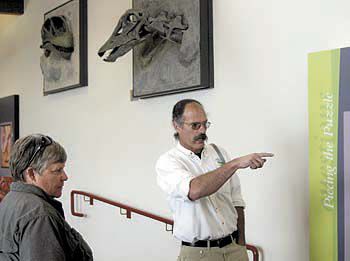| Quarry manager Michael Leschin discusses theories about how fossils were deposited at Cleveland-Lloyd Dinosaur Quarry with visitor Anne Kinney. The BLM-operated quarry reopened for visitors last week after a 20-month renovation project with a price tag just under $1 million. |
Staff at the Cleveland-Lloyd Dinosaur Quarry welcomed 111 visitors to a renovated facility that reopened to the public last Friday.
After closing at the end of July 2005, the quarry underwent a renovation before reopening for visitors on March 23.
Michael Leschin, manager of the quarry, said renovations at the site, which is operated by the United States Bureau of Land Management cost just under $1 million.
Additions at the site include an expansion to the visitor center and improvements to two metal structures which cover ongoing excavations.
The addition to the west of the existing visitor center more than doubled the space for exhibits, explained Leschin.
He said he hopes the improvements at the facility will attract new visitors to the site.
Prior to closing in 2005, the quarry received more than 5,000 visitors annually.
On Friday morning, staff welcomed the first visitor to the renovated facility.
Montana resident Anne Kinney said she was headed home after a stay in Arizona when she saw signs on U.S. Highway 6 and decided to take a detour.
The quarry is located at the north end of the San Rafael Swell.
The most traveled access to the site is through the towns of Cleveland and Elmo in Emery County.
Visitors to the swell can also find the quarry just a few miles from Buckhorn Wash.
Travelers in the region can follow numerous signs on highways and gravel roads.
Almost any motorized vehicle can access the site, but tourists should make sure they are prepared before venturing off the beaten path.
One of the most dramatic changes visitors to the quarry will notice are designed interpretive exhibits.
New interpretive display allow visitors to walk through the center with or without a guided tour from staff.
Leschin explained that prior to the renovations, staff had to explain a lot more to visitors using an ad-hoc collection of exhibits that did not tell a complete story about the quarry.
In developing new plans for the displays at the Cleveland-Lloyd Dinosaur Quarry, the BLM reused portions of older exhibits. The federal agency also added additional portions that were in storage or were designed specifically for the renovated facility.
More than three-quarters of the exhibits are new.
While some displays are recycled from before the renovation, others have been updated or colorized.
Castle Valley residents who are familiar with the old facility will also recognize a handful of trophy mounts lining a wall in the newer portion of the building.
But the centerpiece in the new wing of the visitor center is a complete allosaur, one of most common dinosaurs excavated at the quarry.
The skull of the allosaur mount is a replica from a University of Utah at Dinosaur National Monument near Vernal and the right femur is from Dry Mesa, Colo.
But the rest of the skeleton is from the quarry.
“This is arguably the best allosaur in the world as far as accuracy,” said Leschin.
An identical allosaur mount is set to be used in the Utah Museum of Natural History after renovations are completed there.
The larger facility also provides space for a selection of books and pamphlets supplied through a partnership with College of Eastern Utah’s bookstore.
Another part of the renovation included more solar cells and batteries to power lights in the visitor center.
Many windows in the building still provide ample light, but the new lighting opens the possibility of extending hours.
With a two-person staff to operate the quarry, extending hours in not likely to happen any time soon, pointed out Leschin.
Still, the lights make the visitor center more welcoming and liven some of the darker corners in the building.
Two metal buildings at the quarry site are also getting face lifts.
The two buildings were originally constructed with galvanized steel and then painted – requiring painting every few years.
Because renovations at the visitor center were completed at or just under budget, the BLM was able to use surplus funds to install aluminum siding on the buildings.
Visitors to the quarry can enter one of the metal buildings. A catwalk in that building has been replaced by a pair of platforms.
One platform provides the same birds-eye view of excavation work.
The other is closer to the ground – more in line with what researchers might see when working.
Inside the building, about half of what visitors see is ongoing research.
The other half is comprised of various models and interpretive displays showing how research takes place.
And just like the visitor center, the pair of metal buildings will receive new lighting.
Windows in the buildings’ walls have been supplemented with three skylights in the ceilings of both buildings.
Leschin said scientific research at the quarry has slowed in recent years.
That’s because more paleontologists have focused on China and Argentina, where new discoveries are filling in gaps in the prehistoric Age of Dinosaurs.
The big question still to be answered at the quarry is how the concentration of dinosaur fossils came to be located at the site.
Since scientists first became aware of the site in the 1920s, no theory regarding the matter has stood up against the evidence.
For instance, three-quarters of the fossils found at the quarry site belong to carnivores.
But the majority of the theories would be better supported by more plant eaters.
Further, there are no complete skeletons at the facility. Rather, fossils are dispersed across a large area at the site.
But despite the dispersion, most of the fossils discovered at the Cleveland-Lloyd show little damage.

